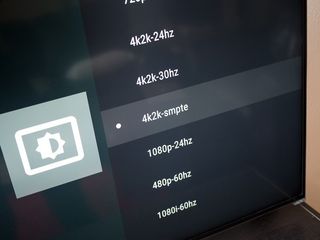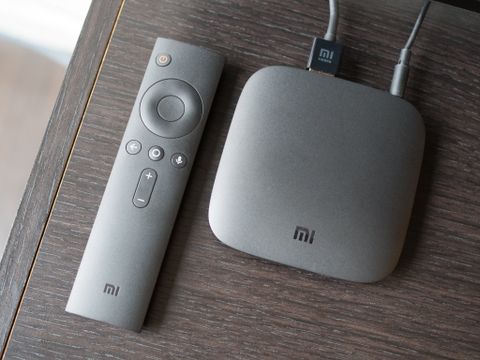The Android TV marketplace is ... sparse. Though there are plenty of happy customers out there using the old Nexus Player or the high-end Shield Android TV, there just isn't a vibrant grouping of choices in the same way you can find an Android phone to fit every want and need. Companies don't see value in making an Android TV box that isn't likely to sell in big numbers, particularly as Chromecast continues to eat away at the low end.
Enter Xiaomi with the Mi Box: a small, nondescript black box offering a full Android TV experience, 4K HDR video and a remote for just $69 — easily the lowest price for one of these devices running a fully sanctioned version of Android TV. Xiaomi has seen some success selling multiple generations of set top boxes under the Mi Box brand running its own customized version of Android adapted to the big screen, but this is its first swing at using Google's proper TV-focused version of Android. And at the same time it's one of only a handful of products it actually sells in the U.S.
Google clearly needs as many companies making Android TV devices as it can get, and Xiaomi would love to expand its brand presence in the U.S., so on the face of it this makes for a great partnership. But does the Xiaomi Mi Box with Android TV live up to the expectations of being "the box to get" — and crucially chosen over the Chromecast Ultra — for Android fans out there? The answer is in this review.

Gets the job done
Xiaomi Mi Box Hardware and accessories
The Mi Box is small and unassuming, and that's just fine with me. Coming in black with a lightly textured plastic exterior, there's nothing exciting here. At just 101 mm square it isn't much larger than the Qi charging pad next to it in my entertainment center. It's small enough that you could easily get away with stashing it behind another box or even double-sided taping it to the back of the TV if needed.
The little rounded square sits up off of any flat surface with a rubberized ring that keeps the relatively light box from sliding around from the bends of stiff cables. The ports are all hidden nicely on the back, and the only thing aside from that on the box is a small "Mi" logo on the top and a very faint white LED on the front edge indicating that the box is awake.




Xiaomi's remote gets the job done, though it isn't as sleek or nice as the one available for the (over twice as expensive) NVIDIA Shield Android TV. A circular directional pad with a button highlights the top while standard Android TV controls and a volume rocker sit underneath it. The remote is Bluetooth, of course, and runs on two AAA batteries that are included in the box. The one big downside for me here is that the remote doesn't offer a 3.5 mm headphone jack for plugging in headphones for personal listening, which is something you get with boxes like the Roku 4 and Shield Android TV — then again, the Mi Box is less expensive too.
The cables are on the short side, but at least they're included.
When it comes to cables, things are as basic as the box itself. The Mi Box ships with an HDMI cable in the box (unlike Amazon's Fire TV) though the cable itself is only about three feet long. The power cord is an integrated unit with a relatively large brick on the outlet end and a barrel connector on the box's end — the cord is also about three feet in length. Considering how inexpensive HDMI cables are it's hard to complain about having a short one in the box, but the short power cord without a standard connector (like USB-C or even Micro-USB) can hamstring the possibilities of placing the box around your entertainment center setup.
Every set top streamer is going to have its little hardware quirks, and the Mi Box overall isn't at any real disadvantage compared to the rest. For most people, simply plugging in the two included cables will be the only physical interaction they have with the Mi Box for months. And the one part of the experience you actually touch, the remote, feels nice enough and performs its intended functions perfectly.

Coming up short on 4K
Xiaomi Mi Box Software and experience
One of the strong suits of Android TV is that it's nearly identical across boxes and TV sets that run the software. The idea is that you can pick up the remote to any Android TV device and navigate around freely, save for a few changes in the settings (for specific device functions). Xiaomi, like other Android TV makers, offers a "Mi Box recommends" section on the home screen showing some content apps that you've heard of before, but that's it in terms of customizations.
Android TV really doesn't get enough credit for what it does well.
Android TV still doesn't offer a massive collection of apps, but all of the mainstays are here — Netflix, Hulu, Fox Sports, ESPN, Sling TV, Vudu, Pandora, CBS, Showtime, HBO Go, Plex, VLC ... the list of big names goes on. It is also a fantastic portal for Google's own media services, including YouTube, Google Play Movies & TV and Google Play Music. It's all enhanced further by the inclusion of Google Cast support, with tons of additional content offerings there. Though the Mi Box supports Bluetooth game controllers the game offerings just aren't there on Android TV — but to be fair the likes of the Fire TV haven't taken the gaming world by storm either.
I don't think Android TV gets enough credit for being a really good-looking and easy-to-use interface with most of the big-name apps that the average person is looking for. And when it's paired with the right hardware I'd take it over the competition, especially if you're at all hooked into the Google services ecosystem.

Inside the Mi Box is a very run-of-the-mill spec arrangement, with a 2GHz quad-core (Cortex-A53) processor, 2GB of RAM and 8GB of storage — the latter of which capable of being expanded via a full-sized USB-A port on the back. That's all about in line with what you get from other set top boxes in this price range, but unfortunately that hardware can't provide a great experience when displaying content at its full advertised 4K resolution.
As I touched on separately before writing this full review, the Mi Box really chugs along when you leave it set to its default 4K resolution. It seems as though the hardware should be able to handle it, but somewhere along the line between that hardware and the software optimization it just can't keep up a smooth frame rate in the same way that the Chromecast Ultra can. Things smooth out and work just fine when you set it to 1080p, and that's probably fine for most people who don't have a 4K TV let alone 4K content to watch, but for a box that's marketed as supporting 4K resolution it's a real bummer to admit defeat and lock it down to a lower resolution.
The one other software shortcoming on the Mi Box seems to be an exacerbation of an overall Android TV problem in that it doesn't do a great job of automatically sleeping and waking up on its own. In what seems like an admission of the problem, unlike some other Android TV boxes the Mi Box actually has a "power" button on it, which you can press to forcibly sleep the box and then press again to wake it explicitly. If you don't sleep the Mi Box it stays available all the time as a Google Cast target, which is good, but at the same time it also seems to randomly wake itself — and because of HDMI-CEC, it will turn on your TV in the process. After a few nights of waking up to my TV turning on to the Android TV interface, I started forcing it to sleep with the remote when I was done using it.

In an awkward position
Xiaomi Mi Box Bottom line
The addressable market for the Mi Box is much smaller than I originally thought when the box was first announced. At the same price as the new Chromecast Ultra, fans of the Google ecosystem will be better served by Google's own streamer that offers more consistent performance and simpler setup. If the Chromecast Ultra's lack of a physical remote is a shortcoming (which it undoubtably is for many), there are other options out there. For $20 more you could get Amazon's Fire TV with better performance, near-identical content offerings and also a full remote, or a Roku 4 with similar characteristics. For $30 less than the Mi Box you could snag the simpler Fire TV Stick with a remote, or Roku's Streaming Stick competitor.
The Mi Box sits in a weird middle ground; one that doesn't have many potential customers.
That puts the Mi Box in a weird middle ground, where it only really appeals to diehard Android fans who love Android TV itself, shunning boxes and sticks from Amazon and Roku, but also don't want to lay out the cash for something like the NVIDIA Shield Android TV. Because if you look just at performance and interaction with Google's ecosystem, the Chromecast Ultra is a better bet; and if you look at performance and availability of a remote while also having almost the exact same content offerings, Amazon and Roku offer better choices.
2.5 out of 5
Xiaomi's Mi Box is a very interesting offering that can succeed as a low-selling streamer that appeals to those who want Android TV exclusively and don't want to pay much for it. But as the flag-bearer that is the only recently released Android TV box, it lets down the ecosystem with its inconsistent performance and will not steal many customers away from Amazon, Roku and Google itself.
Andrew was an Executive Editor, U.S. at Android Central between 2012 and 2020.

